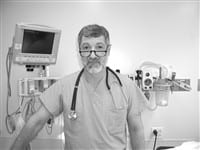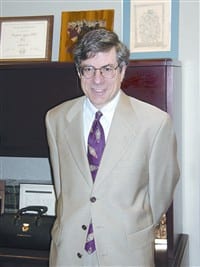Doctor: Nuclear Policy A Prescription For Trouble
When he isn’t tending to patients in the emergency room at Cooley Dickinson Hospital in Northampton, Dr. Ira Helfand is often pondering scenarios that most of us would rather not think about.
He’s spent considerable time recently, for example, trying to assess what would happen if a nuclear bomb the size of the one dropped on Hiroshima were to be detonated in a large urban area. Using New York City as a test case, he and others working on the project determined that such a blast in the city’s harbor would kill 52,000 immediately, and that radiation fallout would eventually kill another 200,000.
Exercises like this one are part of Helfand’s work with the Physicians for Social Responsibility (PSR), a Nobel Prize-winning group that has committed itself to educating the public about the dangers of nuclear power and especially nuclear weapons, and to lobby tirelessly for the abolition of such devices.
Formed in 1978 during one of the tensest periods of the Cold War, PSR counted more than 50,000 physicians and health professionals in its ranks at one time. The end of the Cold War and reduced reliance on nuclear power have thinned those ranks to about 20,000, said Helfand, but recent events have given PSR a renewed sense of mission.
Indeed, the attacks of Sept. 11 have shown what terrorists are capable of, and they have thrust the possible use of nuclear weapons in the next terrorist act into the spotlight. Meanwhile, the Bush administration’s stance on nuclear weapons, a radical departure from administrations past, has given PSR fresh cause for alarm.
The administration’s new Nuclear Posture Review, presented to Congress in January and leaked to the Los Angeles Times earlier this month, amounts to what many consider a major expansion of the role of nuclear weapons in U.S. military policy. Helfand, former president of the PSR and one of its co-founders, calls the policy change a prescription for disaster.
“In the past, we’ve used nuclear weapons primarily as a deterrent, to keep other countries from using them against us,” he explained. “But what’s emerged now is that we’re exploring circumstances under which we’d use them in non-deterrent ways, and this is alarming.”
The Healthcare News talked with Helfand recently about PSR and its renewed sense of urgency.
Numbers Game
Helfand said he first became concerned about nuclear power and its threat to global health and safety in the late ’70s, during development of the Seabrook nuclear power plant in New Hampshire. The height of the opposition to that project occurred while he was in residency in Boston, “a year when you don’t have much time for anything but your residency.”
So he opposed the project from afar, as he put it, and decided to put his efforts into education about nuclear power. In 1978, he and two other physicians founded PSR, which was actually a reincarnation of a group with the same name that was quite active at the height of the Cold War in the early ’60s, he said. It is also the U.S. component of a larger group called International Physicians for the Prevention of Nuclear War.
Helfand has been active with PSR since its formation. He was the group’s president in 1996 and has made numerous trips to the former Soviet Union to meet with doctors there about the global nuclear threat. He’s also traveled to other countries with nuclear capability, including India and Pakistan, to gauge both the scope of the problem and the politics that defines it.
And while 9/11 changed the landscape for nuclear terrorism in many ways and put the issue on the front page, he said, the threat has always been there, especially since the demise of the Soviet Union more than a decade ago.
Helfand pieced together his New York doomsday scenario for an article he co-authored for the British Medical Journal to drive home not only the consequences of a nuclear attack, but the fact that the threat is, indeed, very real.
Using the CATS (Consequences Assessment Tool Set) software created by the U.S. Federal Emergency Management Agency and the Defense Threat Reduction Agency, Helfand and co-authors Lachlan Forrow and Jaya Tuwari calculated the expected casualties from a 12.5-kiloton nuclear explosion at ground level in New York.
In addition to the 52,000 initial casualties, direct radiation would cause 44,000 cases of radiation sickness, of which 10,000 would be fatal, he said, adding that radiation from fallout would cause several hundred thousand additional cases of radiation sickness.
Assessing the impact of such a blast on the city’s ability to aid survivors, he said such a response would be very limited. About 1,000 hospital beds would be destroyed by the blast, and 8,700 more would be in areas with radiation exposures high enough to cause radiation sickness. “The remaining local medical facilities would quickly be overwhelmed, and even with advance preparation, outside help would be delayed,” he wrote.
Helfand said he authored the story to replace conjecture about what might happen in a nuclear calamity with some hard numbers. “People know such an event would be bad,” he told The Healthcare News. “But everyone’s mind stops short of understanding just how bad it would be.”
But presenting the numbers was only part of his motivation. He also wanted readers — and later a Congressional audience — to understand that the threat is real, especially with the state of security in the former Soviet Union, where there are tens of thousands of tactical nuclear warheads and 603 metric tons of weapons-grade nuclear material stored at 53 different sites.
“There is clear evidence that some terrorist groups have been trying to obtain nuclear materials, primarily from the enormous stockpiles of the former Soviet Union,” he said, adding that the Al-Qaida network has tried to buy uranium from South Africa and weapons-grade material and even complete nuclear weapons from three central Asian states.
Noting that the size of such weapons is becoming progressively smaller — some 12-kiloton bombs being assembled today are no bigger than an office copier — the task of preventing a detonation by a terrorist group becomes that much harder.
“A bomb could easily be concealed in a cargo carrier,” he said, adding that the U.S. must rely on more than what he called the “goal-line defense” of the CIA and the New York Police Department.
Ultimately, the only way to eliminate the possibility of nuclear terrorism is to eliminate those weapons, said Helfand, adding quickly that at the moment, the Bush administration seems determined to move in the other direction on the issue — embracing possible new uses of such weapons rather than moving to abolish them.
Call for Action
The administration’s new Nuclear Posture Review effectively lowers the bar for the use of nuclear weapons, recommending that they could be deployed against countries that don’t possess nuclear weapons, in response to another country’s use of chemical, biological, or nuclear weapons, or in the event of other military developments, Helfand noted. “This sends the wrong signal to other countries around the world,” he said. “The clear message that it sends is that if you want to stand up to the U.S., then you need nuclear weapons too.”
What’s more, the new policy works not to mitigate the threat of nuclear terrorism, but to exacerbate it, he said, because it stimulates the proliferation of nuclear weapons, thereby increasing terrorists’ ability to obtain such devices.
In a letter to the president, the PSR called upon the administration to shift U.S. priorities away from military solutions and toward nuclear disarmament. “We need to have a nuclear weapons convention,” said Helfand, “where nations could agree on ways to end production of nuclear material and put all the material currently in existence in safe storage.”
While acknowledging that this is an ambitious goal, Helfand says it’s the only way to resolve the current problem, and it will continue to be PSR’s primary objective.
“We have to keep trying to move the world in that direction,” he explained. “Anything short of that, and we are never really safe.”



Comments are closed.